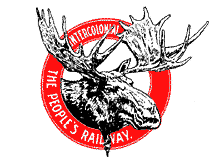
The Intercolonial Railway/ Canadian Government Railways




| Click on the icons to have access to the photo collection |
|
In 1867, the Government of Canada organized the Intercolonial Railway to fulfil a condition of Confederation,
linking the Maritime provinces by railway to the St. Lawrence River at
or near Quebec City. The Intercolonial assumed ownership of the provincially
owned railways in Nova Scotia and New Brunswick. Construction began shortly
afterwards, with the noted Canadian civil engineer Sanford Fleming as engineer
in chief. The first section of track between Truro and Amherst, Nova Scotia, was opened in November 1872, and that between Rivière-du-Loup and Ste. Flavie (now Mont-Joli) Quebec, in August 1874. The line between Campbellton and Moncton, New Brunswick was completed in 1875, and between Campbellton and Ste. Flavie in 1875. On July 1st of that year, the entire line was declared opened for traffic. The Intercolonial acquired the Grand Trunk Railway line from Rivière-du-Loup to Point Lévis, Quebec in 1879 and, 10 years later, running rights over the GTR line to Montreal. The Canadian Government Railways was the descriptive name of all federally-owned railways in Canada (the Intercolonial; the National Transcontinental Railway; the Prince Edward Island Railway; and the Hudson Bay Railway) from the 1880's until 1918. That year, the operations of the CGR were combined with the Canadian Northern Railway; the following year the Canadian National Railways were incorporated to operate both companies. The Intercolonial, built to fulfil the terms of Confederation, was never a commercial success. However, it provided employment, and helped in the development of towns and villages along its route. CN's main line in the Maritimes follows much of the Intercolonial's route. |







 
|
 |
Canadian Northern | Grand Trunk Railway | Canadian National Railways
CN | Grand Trunk Pacific
Copyright © 1996 CN, Copyright © 1996 NMSTC, all rights reserved. Copyright © 1996 CN, copyright © 1996 NMSTC, tous droits réservés.